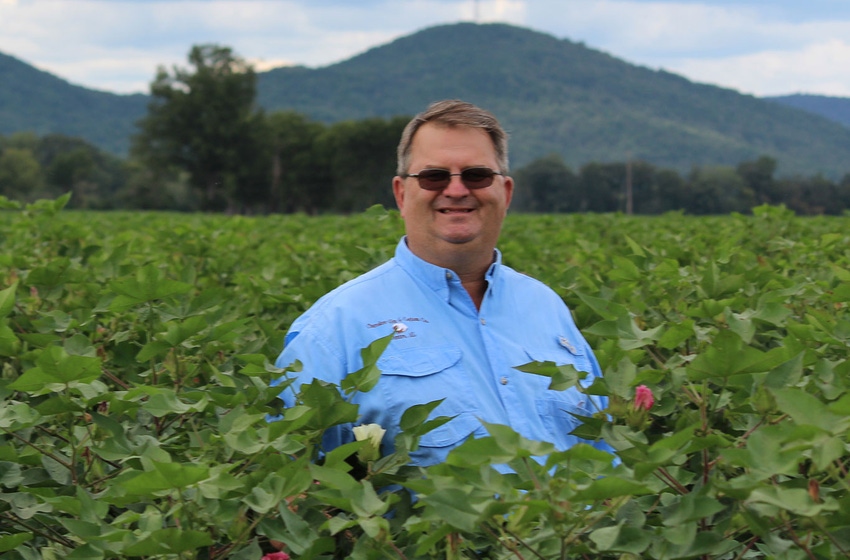November 5, 2020

To keep the family’s farm strong, Nick McMichen does a few key things: He listens to the advice of close farming friends, learns from them and doesn't balk at adjusting his approach to farming.
Take his venture into skip-row cotton. The practice has been around for many years, but a friend reintroduced McMichen to the planting pattern.
“My friend Shawn Holiday, a Texas cotton producer, told me long ago that cotton planted in a skip-row pattern offered drought protection because fewer plants are competing for moisture at any given time. It’s just a more efficient water-use row configuration," he said, adding he continues to see other benefits from skip-row.
McMichen's operation is based in Centre, Ala., and stretches 60 miles over variable soils in two counties in Alabama and one county in Georgia. McMichen has listened to the advice of other close farming friends, like Sam Spruell and Neal Isbell, past presidents of Southern Cotton Growers, or SCG, but McMichen always pencils out the economics of everything, including skip-row cotton.
“We’re saving (or eliminating) 33% of seed technology fees, our crop insurance costs are 44% less and we’re utilizing 20% more with a picker that costs $750,000,” McMichen says. “Skip-row is saving me around $70 an acre, it has almost eliminated boll rot because more air infiltrates the plant canopies, and skip-row cotton is much more forgiving if some aspect of the crop gets away from me.”
No Plow
With 2,400 acres of cotton this year across such a large area, it kept McMichen’s son-in-law moving at a torrid pace during irrigation season. “One-third of our acreage is irrigated, mostly through pivots with pumps pulling water from retention ponds we built in conjunction with NRCS,” said Tyler Bruce, who is married to Nick and Freida McMichen’s daughter, Mindy, the family’s accountant. “I cut the pumps off with my phone, but they have to be fueled and started manually. I put almost 20,000 miles on my truck in three months. I’m in my truck more than I am on a tractor.”
Other than working new ground into shape, a plow has not been hooked to a tractor on the McMichen Farm since 1996.
“That’s how long we’ve been continuous no-till. My fuel and equipment costs would be exorbitant if I had to till every acre,” McMichen said. “Our acreage goes from rolling terrain and clay, to flat alluvial river bottoms, but we’ve figured out how to make no-till work thanks to my friend Dr. John Bradley (superintendent of the Tennessee Milan Research Station and Mr. No-till) and others."
While working with Auburn University in conjunction with the University of Georgia to conduct variety trials on some of his ground, he ran into a seed-depth problem trying to plant into a thick cover of rye and radishes.
“I let the rye get too tall and even after burndown, the planter’s coulters and row cleaners couldn’t get through that thick cover to allow good seed-to-soil contact, so seeds were ‘hair pinned,’” McMichen said. “That’s when I heard about a roller crimper. It compresses the rye, allows the planter to peel back the cover for much better seed placement and solves the problem. No-till and cover crops have changed the way we farm. A cover crop retains moisture so well and gets us through short periods of drought.”
Ahead of Resistance
When resistant weeds started developing in the southeast, McMichen and other farmers were prepared. “I serve as treasurer on the SCG board. SCG continues to be an important organizational conduit for farmer-to-farmer communication, education, and maintains a strong relationship with the National Cotton Council,” McMichen said.
McMichen and Georgia cotton producer Lee Cromley were invited to Washington, D.C. by the EPA to explain why drift issues were so low in their respective states.
“We told them how SCG and all land-grant universities in our states place great emphasis on proactive grower education. We continue to follow all local Extension service recommendations and let neighboring farmers know when we’re going to use products like dicamba. They also encourage us to put out residuals and rotate chemistries. While growing environments vary, much of our success comes down to abiding by product labels and simply using common sense.”
All U.S. cotton producers face unique problems specific to their growing regions. McMichen and other southeast farmers have stayed abreast of the contentious water right disputes facing many southwest and western farmers.
“David Ruppenicker, chief executive officer of SCG, does an excellent job of keeping us current on issues impacting us now, or those that could impact us in the future,” McMichen said. “The SCG staff also forwards ideas, concerns and solutions we bring forth in our meetings to our national cotton organizations. SCG and the Southeastern Cotton Ginners Association maintain advocacy for grower and ginner segments across the southeastern states.”
Source: Southern Cotton Growers, which is solely responsible for the information provided and is wholly owned by the source. Informa Business Media and all its subsidiaries are not responsible for any of the content contained in this information asset.
You May Also Like




